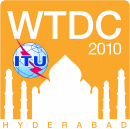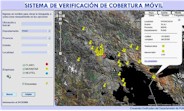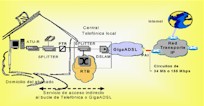| |
|
Summary |
|
|
| |
|
What is CITEL? |
|
|
| |
|
Links |
|
|
| |
|
Information |
|
|
| |
| |
|
| |
|
Latest News |
|
|
|
Inter-American proposals for
the World Telecommunication Development Conference
(WTDC-10) |
|

The XIX Meeting of the Conference Preparatory
Working Group to Address Regional Preparations for
World Conferences and Meetings at the World
Telecommunication Development Conference (WTDC-10)
began on May 23, 2010, , Hyderabad, India.
The objective of WTDC-10 is to identify
priorities for the development of telecommunications
and information and communication technologies (ICTs),
taking into account contributions made by Member
States and Sector Members, and to adopt the
Hyderabad Action Plan (HAP) setting the future of
activities of the ITU Telecommunication Development
Sector (ITU-D) over the next four-year period.
CITEL presented inter-american proposals on the
following subjects:
- Support for non-profit entities providing
telecommunication services in underserved suburban
and rural areas
- Modification to Resolution 53 – Strategic and
financial framework for the elaboration of the
Hyderabad Action Plan
- Evaluation of the ITU-D Study Groups
- Support for studying the impact of
telecommunications on the environment and climate
change and the effects of non-ionizing radiation
- Integrating assistance to indigenous peoples
within the activities of BDT and its various
programmes
- Revision of the work of ITU-D Study Groups 1
and 2
- America's regional initiative on digital
broadcasting
- Protecting and strengthening users of
telecommunication services / information and
communication technologies
- Consolidation of national telehealth systems
- Support for continuation of cybersecurity
studies in ITU-D Question 22/1: Securing
information and communication networks: Best
practices for developing a culture of
cybersecurity
- Strengthening coordination and cooperation
between ITU-D and ITU-T on matters of mutual
interest and concern
- Creation of the compendium of public policies
on the digital terrestrial radio and television
transition
- ICT and the environment
|
|
more information |
|
|
CITEL Strategic Plan for
2010-2014 |
|
|
The Fifth Regular Meeting of the Assembly, Working
Committee 1, “Structure and Strategic Planning,” was
formed, which prepared the Strategic Plan for
2010-2014, containing the vision, purpose,
telecommunications/ICT environment, strategic goals,
specific objectives, and plan of action for that
term. |
|
more information |
|
|
Important issues |
|
OSIPTEL incorporates new
functions to the Mobile Coverage Information System
By Ernesto Loayza, Gerencia de Fiscalización
del OSIPTEL |
|
 The
OSIPTEL SIGNAL Mobile Coverage Information System (SEÑAL
OSIPTEL) was presented as a contribution of the
Supervisory Authority for Private-Sector Investment
in Telecommunications of Peru (Organismo Supervisor
de Inversión Privada en Telecomunicaciones del Perú—OSIPTEL)
on the occasion of the XIV Meeting of Permanent
Consultative Committee I (CCP.I) of the
Inter-American Telecommunication Commission (CITEL),
held in May 2009 in Cuzco, Peru. The
OSIPTEL SIGNAL Mobile Coverage Information System (SEÑAL
OSIPTEL) was presented as a contribution of the
Supervisory Authority for Private-Sector Investment
in Telecommunications of Peru (Organismo Supervisor
de Inversión Privada en Telecomunicaciones del Perú—OSIPTEL)
on the occasion of the XIV Meeting of Permanent
Consultative Committee I (CCP.I) of the
Inter-American Telecommunication Commission (CITEL),
held in May 2009 in Cuzco, Peru. |
|
more information |
|
Assistance of the Dominican
Republic in the recovery of telecommunications in
Haiti after the disaster of January 12, 2010
By Javier García, INDOTEL |
|
|
The Dominican Republic and the
Republic of Haiti shares the island of Hispaniola.
In turn Haiti has approximately 27.750 Km2 of
territory with a population of 9,035,536
inhabitants, and the territory of the Dominican
Republic has approximately 48, 670 km2 with a
population of 9, 650.054.
Haiti's earthquake was registered on January 12,
2010 at 16:53:09 local time (21:53:09 UTC) with
epicenter at 15 km from Port au Prince, Haiti's
capital. According to the U.S. Geological Survey,
the quake had a magnitude of 7.0 degrees and was
generated at a depth of 10 km. There has also been a
series of aftershocks, the strongest being the 5.9,
5.5 and 5.1 degrees. This earthquake was the
strongest recorded in the area since 1770. The quake
was felt in nearby countries such as Cuba, Jamaica
and the Dominican Republic where it caused fear and
precautionary evacuations. It is believed that
approximately more than 300,000 people died from the
direct or collateral effects of this natural
disaster. |
|
more information |
|
Seminar on “The Internet
Access Ecosystem and Network Neutrality”
By the Coordination of the Seminar |
|
|
 The
seminar on “The Internet Access Ecosystem and
Network Neutrality”, co-organized by CITEL PCC.I and
Internet Society (ISOC), was held in the city of
Ushuaia, Argentina, on May 10, 2010. The
seminar on “The Internet Access Ecosystem and
Network Neutrality”, co-organized by CITEL PCC.I and
Internet Society (ISOC), was held in the city of
Ushuaia, Argentina, on May 10, 2010.
The main purpose of this seminar
focused on three areas, which are in turn closely
connected: the way in which the Internet environment
operates (the Internet Model), the various actors
and processes that compose it and permit access to
the Internet (the Internet Access Ecosystem) and the
relation between these factors and one of the most
prevalent factors today: the concept of Network
Neutrality, which is now being substituted in
discussions by Open Inter-Networking. These three
areas were the titles of the panels that were
presented. |
|
more information |
|
Standardization of the Critical
Infrastructure in Brazil - MAI2C
By Sérgio Ribeiro, CPqD |
|
|
The critical telecommunication infrastructure
protection model – previously presented in info@CITEL
– is implemented by a set of five methodologies.
Although each methodology is responsible for a
specific part of the model, they are interdependent,
since the output of one is the input of another.
Although MAI2C output is used by other methodology
(Methodology for Diagnosing Critical Infrastructure
– MeDI2C), it has a singular characteristic: it can
be applied in an isolated way, since MAI2C doesn’t
receive input from another methodology. Moreover,
MAI2C can be applied considering different contexts:
whole country, region, state, city, period of the
year, sport events, etc. Depending which context is
considered, the interdependency analysis may produce
different results. |
|
more information |
|
|
Training |
|
Development of the ADSL
technology
By Instituto Nacional de Investigación y
Capacitación de Telecomunicaciones, INICTEL-UNI,
Universidad Nacional de Ingeniería (UNI) |
|
 The
origin of this technology dates back to attempts to
provide TV and video on demand through the copper
pair. The
origin of this technology dates back to attempts to
provide TV and video on demand through the copper
pair.
The first technical specifications of the xDSL
family (which includes the ADSL) date back to 1987
and were developed in the Bell Communications
Research (Bellcore), which previously has developed
ISDN. Although it was not until 1989 that the
company develops completely ADSL, to provide
broadband data transmission services over
conventional telephone wiring thus obtaining maximum
benefits of the traditional copper network
traditionally used for telephony. |
|
more information |
|
|
|



 The
OSIPTEL SIGNAL Mobile Coverage Information System (SEÑAL
OSIPTEL) was presented as a contribution of the
Supervisory Authority for Private-Sector Investment
in Telecommunications of Peru (Organismo Supervisor
de Inversión Privada en Telecomunicaciones del Perú—OSIPTEL)
on the occasion of the XIV Meeting of Permanent
Consultative Committee I (CCP.I) of the
Inter-American Telecommunication Commission (CITEL),
held in May 2009 in Cuzco, Peru.
The
OSIPTEL SIGNAL Mobile Coverage Information System (SEÑAL
OSIPTEL) was presented as a contribution of the
Supervisory Authority for Private-Sector Investment
in Telecommunications of Peru (Organismo Supervisor
de Inversión Privada en Telecomunicaciones del Perú—OSIPTEL)
on the occasion of the XIV Meeting of Permanent
Consultative Committee I (CCP.I) of the
Inter-American Telecommunication Commission (CITEL),
held in May 2009 in Cuzco, Peru.  The
seminar on “The Internet Access Ecosystem and
Network Neutrality”, co-organized by CITEL PCC.I and
Internet Society (ISOC), was held in the city of
Ushuaia, Argentina, on May 10, 2010.
The
seminar on “The Internet Access Ecosystem and
Network Neutrality”, co-organized by CITEL PCC.I and
Internet Society (ISOC), was held in the city of
Ushuaia, Argentina, on May 10, 2010.  The
origin of this technology dates back to attempts to
provide TV and video on demand through the copper
pair.
The
origin of this technology dates back to attempts to
provide TV and video on demand through the copper
pair.